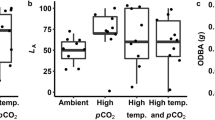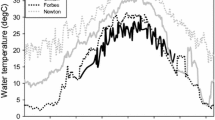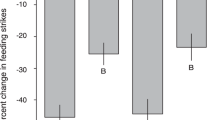Abstract
Anthropogenic climate change is expected to result in dramatic shifts in the abiotic conditions within estuaries, including an elevation of temperature and salinity levels. Even so, few studies have addressed the impacts of multiple abiotic stressors on the behaviour and life history of key estuarine species, such as those of biological and commercial importance. Here we used a cross-factored experimental design to tease apart the effects of temperature and salinity on intraspecific aggression and growth rates of a native estuarine fish species, the Australian bass (Macquaria novemaculeata). Juvenile bass were exposed to one of four treatment conditions: 1) baseline temperature and salinity, 2) elevated temperature, 3) elevated salinity, and 4) elevated temperature and salinity. Elevated salinity increased rates of aggression, and elevated temperature decreased rates of growth, although the effects of both factors were mediated by the body size of individual bass. These results therefore highlight complex and variable effects of abiotic stressors and body size, emphasising the importance of considering individual-level attributes when evaluating the impacts of climate change on estuarine fishes.



Similar content being viewed by others

References
Alcaraz C, Bisazza A, Garcia-Berthou E (2008) Salinity mediates the competitive interactions between invasive mosquitofish and an endangered fish. Oecologia 155:205–213
Bachman PM, Rand GM (2008) Effects of salinity on native estuarine fish species in South Florida. Ecotoxicology 17:591–597
Barnham C, Baxter A (1998) Condition factor, K, for salmonid fish. Fisheries Notes FN0005
Biro PA, Beckmann C, Stamps JA (2010) Small within-day increases in temperature affects boldness and alters personality in a coral reef fish. Proc R Soc Lond B 277:71–77
Boeuf G, Payan P (2001) How should salinity influence fish growth? Comp Biochem Physiol C 130:411–423
Booth DJ, Bond N, MacReadie P (2011) Detecting range shifts among Australian fishes in response to climate change. Mar Freshw Res 62:1027–1042
Burke JB (1992) The effect of salinity in the extensive rearing of Australian bass Macquaria novemaculeata. Larval Biol 1992:73
Burton T, Metcalfe NB (2014) Can environmental conditions experienced in early life influence future generations? Proc R Soc Lond B 281:20140311
Cameron LM, Baumgartner LJ, Bucher DJ, Robinson W (2012) Critical thermal minima of age-0 Australian bass, Macquaria novemaculeata fingerlings: implications for stocking programmes. Fish Manag Ecol 19:344–351
Cardona L (2000) Effects of salinity on the habitat selection and growth performance of mediterranean flathead grey mullet Mugil cephalus (Osteichthyes, Mugilidae). Estuar Coast Shelf Sci 50:727–737
Chen JC, Lin J, Chen C, Jin M (1996) Survival, growth and intermolt period of juvenile Peneaus chinensis reared at different combinations of salinity and temperature. J Exp Mar Biol Ecol 204:169–178
Diouf K, Panfili J, Labonne M, Aliaume C, Tomás J, Do Chi T (2006) Effects of salinity on strontium:calcium ratios in the otoliths of the West African black-chinned tilapia Sarotherodon melanotheron in a hypersaline estuary. Environ Biol Fish 77:9–20
Dunson WA, Travis J (1991) The role of abiotic factors in community organization. Am Nat 138:1067–1091
Elliott M, Whitfield AK, Potter IC, Blaber SJM, Cyrus DP, Nordlie FG, Harrison TD (2007) The guild approach to categorizing estuarine fish assemblages: a global review. Fish Fish 8:41–268
Fielder DS, Heasman MP (2011) Hatchery manual for the production of Australian Bass, Mulloway and Yellowtail Kingfish Ind Invest NSW
Fulton TW (1902) The rate of growth of fishes. 20th Ann Report Fishery Board Scotland 1902:326–446
Gillanders BM, Elsdon TS, Halliday IA, Jenkins GP, Robins JB, Valesini FJ (2011) Potential effects of climate change on Australian estuaries and fish utilising estuaries: a review. Mar Freshw Res 62:1115–1131
Gillson J (2011) Freshwater flow and fisheries production in estuarine and coastal systems: where a drop of rain is not lost. Rev Fish Sci 19:168–186
Grigaltchik VS, Ward AJW, Seebacher F (2012) Thermal acclimation of interactions: differential responses to temperature change alter predator-prey relationship. Proc R Soc Lond B 279:4058–4064
Hall KC, Butcher PA, Broadhurst MK (2009) Short-term mortality of Australian bass, Macquaria novemaculeata, after catch-and-release angling. Fish Manag Ecol 16:235–247
Harris JH (1986) Reproduction of the Australian bass, Macquaria novemaculeata (Perciformes: Percichthyidae) in the Sydney Basin. Aust J Mar Freshwat Res 37:209–235
Harris JH (1987) Growth of Australian bass Macquaria novemaculeata (Perciformes: Percichthyidae) in the Sydney Basin. Aust J Mar Freshwat Res 38:351–361
Hobday AJ, Lough JM (2011) Projected climate change in Australian marine and freshwater environments. Mar Freshw Res 62:1000–1014
Hoeksema SD, Chuwen BM, Potter IC (2006) Massive mortalities of the black bream Acanthopagrus butcheri (Sparidae) in two normally-closed estuaries, following extreme increases in salinity. J Mar Biol Assoc UK 86:893–897
Ingram BA (2009) Culture of juvenile Murray cod, trout cod and Macquarie perch (Percichthyidae) in fertilised earthen ponds. Aquaculture 287:98–106
Jobling M (1997) Temperature and growth: modulation of growth rate via temperature change. In: Wood CM, McDonald DG (eds) Global warming: implications for freshwater and marine fish. Cambridge University Press, Cambridge, pp 225–254
Kench PS (1999) Geomorphology of Australian estuaries: review and prospect. Austral Ecol 24:367–380
Koehn JD, Hobday AJ, Pratchett MS, Gillanders BM (2011) Climate change and Australian marine and freshwater environments, fishes and fisheries: synthesis and options for adaptation. Mar Freshw Res 62:1148–1164
Labonne M, Morize E, Scolan P, Lae R, Dabas E, Bohn M (2009) Impact of salinity on early life history traits of three estuarine fish species in Senegal. Estuar Coast Shelf Sci 82:673–681
Lortie CJ, Callaway RM (2006) Re-analysis of meta-analysis: support for the stress-gradient hypothesis. J Ecol 94:7–16
Macdonald JI, Crook DA (2010) Variability in Sr:Ca and Ba:Ca ratios in water and fish otoliths across an estuarine salinity gradient. Mar Ecol Prog Ser 413:147–161
Maestre FT, Valladares F, Reynolds JF (2006) The stress-gradient hypothesis does not fit all relationships between plant–plant interactions and abiotic stress: further insights from arid environments. J Ecol 94:17–22
McKinley AC, Miskiewicz A, Taylor MD, Johnston EL (2011) Strong links between metal contamination, habitat modification and estuarine larval fish distributions. Environ Pollut 159:1499–1509
Munday PL, Kingsford MJ, O’Callaghan M, Donelson JM (2008) Elevated temperature restricts growth potential of the coral reef fish Acanthochromis polyacanthus. Coral Reefs 27:927–931
Nelson KC, Palmer MA, Pizzuto JE, Moglen GE, Angermeier PL, Hilderbrand RH, Dettinger M, Hayhoe K (2009) Forecasting the combined effects of urbanization and climate change on stream ecosystems: from impacts to management options. J Appl Ecol 46:154–163
Nordlie FG (2006) Physiochemical environments and tolerances of cyprinodontoid fishes found in estuaries and salt marshes of eastern North America. Rev Fish Biol Fish 16:51–106
Pease BC (1999) A spatially oriented analysis of estuaries and their associated commercial fisheries in New South Wales, Australia. Fish Res 42:67–86
Pethick J (2001) Coastal management and sea-level rise. Catena 42:307–322
Pörtner HO, Farrell AP (2008) Ecology: physiology and climate change. Science 322:690–692
Pörtner HO, Knust R (2007) Climate change affects marine fishes through the oxygen limitation of thermal tolerance. Science 315:95–97
Pratchett MS, Bay LK, Gehrke PC, Koehn JD, Osborne K, Pressey RL, Sweatman HPA, Wachenfeld D (2011) Contribution of climate change to degradation and loss of critical fish habitats in Australian marine and freshwater environments. Mar Freshw Res 62:1062–1081
Ratnasabapathi D, Burns J, Souchek R (1992) Effects of temperature and prior residence on territorial aggression in the convict cichlid Cichlasoma nigrofasciatum. Aggress Behav 18:365–372
Roessig JM, Woodley CM, Cech J Jr, Hansen LJ (2004) Effects of global climate change on marine and estuarine fishes and fisheries. Rev Fish Biol Fish 14:251–275
Roy PS, Williams RJ, Jones AR, Yassini I, Gibbs PJ, Coates B, West RJ, Scanes PR, Hudson JP, Nichol S (2001) Structure and function of south-east Australian estuaries. Estuar Coast Shelf Sci 53:351–384
Saintilan (2004) Relationships between estuarine geomorphology, wetland extent and fish landings in New South Wales estuaries. Estuar Coast Shelf Sci 61:591–601
Sakakura Y, Tsukamoto K (1997) Effects of water temperature and light intensity on aggressive behaviour in the juvenile yellowtail. Fish Sci 63:42–45
Scott GR, Sloman KA (2004) The effects of environmental pollutants on complex fish behaviour: integrating behavioural and physiological indicators of toxicity. Aquat Toxicol 68:369–392
Swanson C (1998) Interactive effects of salinity on metabolic rate, activity, growth and osmoregulation in the euryhaline milkfish (Chanos chanos). J Exp Biol 201:3355–3366
Taborsky M, Grantner A (1998) Behavioural time–energy budgets of cooperatively breeding Neolamprologus pulcher (Pisces: Cichlidae). Anim Behav 56:1375–1382
Taniguchi Y, Nakano S (2000) Condition-specific competition: implications for the altitudinal distribution of stream fishes. Ecology 81:2027–2039
Thomas ML, Holway DA (2005) Condition-specific competition between invasive Argentine ants and Australian Iridomyrmex. J Anim Ecol 74:532–542
Tsuzuki MY, Cavalli RO, Bianchini A (2003) Effect of salinity on survival, growth, and oxygen consumption of the pink shrimp Farfantepenaeus paulensis (Perez-Farfante 1967). J Shellfish Res 22:555–559
Ureche D, Ureche C, Lazar IM (2012) Length-weight relationships and Fulton’s condition factor for nine species of fish captured from the basin of river Casin including some of its tributaries. Environ Eng Manag J 11:2275–2283
Van Der Wal EJ (1985) Effects of temperature and salinity on the hatch rate and survival of Australian bass (Macquaria novemaculeata) eggs and yolk-sac larvae. Aquaculture 47:239–244
Varsamos S, Nebel C, Charmantier G (2005) Ontogeny of osmoregulation in postembryonic fish: a review. Comp Biochem Physiol 141:401–429
Vasconcelos RP, Reis-Santos P, Fonseca V, Ruano M, Tanner S, Costa MJ, Cabral HN (2009) Juvenile fish condition in estuarine nurseries along the Portuguese coast. Estuar Coast Shelf Sci 82:128–138
Wiegmann DD, Baylis JR (1995) Male body size and paternal behaviour in smallmouth bass, Micropterus dofomieui (Pisces: Centrarchidae). Anim Behav 50:1543–1555
Wong MYL, Buston PM, Munday PL, Jones GP (2007) The threat of punishment enforces peaceful cooperation and stabilizes queues in a coral-reef fish. Proc R Soc B 274:1093–1099
Wong MYL, Munday PL, Buston PM, Jones GP (2008) Fasting or feasting in a fish social hierarchy. Curr Biol 18:R372–R373
Wong MYL, Jordan LA, Marsh-Rollo S, St-Cyr S, Reynolds JO, Stiver KA, Desjardins JK, Fitzpatrick JL, Balshine S (2012) Mating systems in cooperative breeders: the roles of resource dispersion and conflict mitigation. Behav Ecol 23:521–530
Acknowledgments
We would like to thank our colleagues, Andy Davis and Adam Munn for their helpful comments on the manuscript. We thank Susan Rhind, Elizabeth Price, Corrine de Mestre and Julie Wright for their technical support and assistance with running the aquarium facilities at the Ecological Research Centre, University of Wollongong. This project was conducted in concordance with animal ethics approval from the UOW Animal Ethics Committee (#13/21). This project was supported by funding from the Institute of Conservation Biology & Environmental Management, School of Biological Sciences, University of Wollongong.
Author information
Authors and Affiliations
Corresponding author
Rights and permissions
About this article
Cite this article
O’Mara, K.M., Wong, M.Y.L. Body size mediated effects of multiple abiotic stressors on the growth and social behaviour of an estuarine fish, Australian Bass (Macquaria novemaculeata). Environ Biol Fish 99, 95–104 (2016). https://doi.org/10.1007/s10641-015-0458-5
Received:
Accepted:
Published:
Issue Date:
DOI: https://doi.org/10.1007/s10641-015-0458-5



